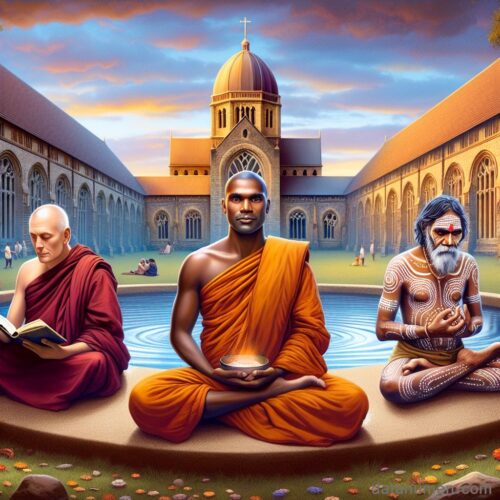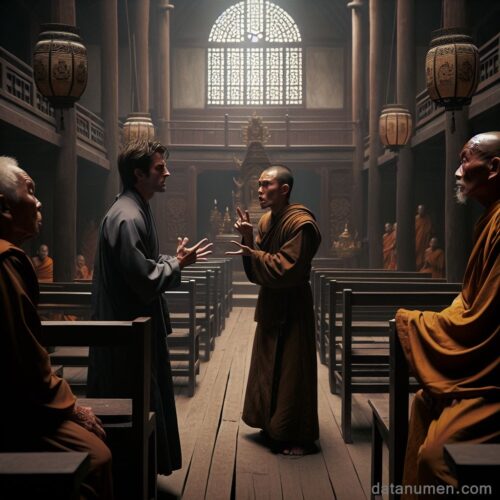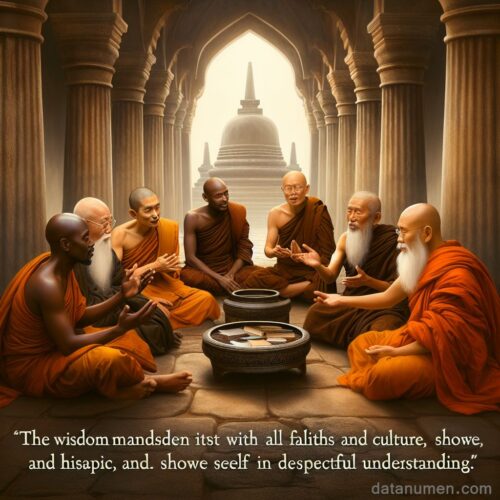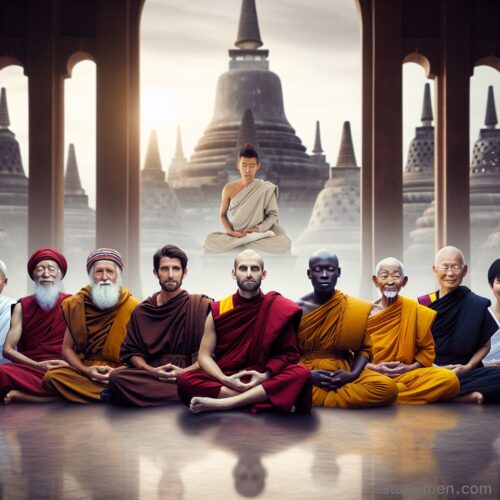Introduction
In a tranquil monastery setting, three monks coexist peacefully despite coming from distinct faith backgrounds. These individuals, representing Christianity, Hinduism, and an indigenous religion, come together in a beautiful display of harmony and mutual respect.
Each monk follows a different set of beliefs and practices, yet they find common ground in their shared values of compassion, humility, and tolerance. Through their daily interactions and spiritual rituals, they demonstrate that despite their differences, coexistence and understanding are achievable.
The monastery serves as a sanctuary where these three individuals can learn from one another, exchange ideas, and grow spiritually. Together, they form a community that transcends religious boundaries and embraces diversity.
As the monks navigate their daily lives within the monastery, they embody the core principles of their respective faiths while also embracing the teachings of their fellow brethren. Through their shared experiences and encounters, they illustrate the power of unity and collaboration in fostering a peaceful coexistence among different belief systems.

2. Conflict arises
The peaceful atmosphere in the monastery is disrupted as the three monks begin to argue about the superiority of their own beliefs. What started as a friendly debate quickly escalates into a heated argument, with each monk fervently defending their own principles. The once harmonious relationship between the monks is now tainted with tension, as egos clash and tempers flare.
The first monk, firmly rooted in his traditional beliefs, staunchly upholds the practices handed down through generations. He believes that adherence to these customs is essential for spiritual enlightenment and refuses to consider any alternative viewpoints.
The second monk, influenced by his own experiences and studies, argues that there is merit in exploring different perspectives and adapting to modern understandings. He advocates for a more open-minded approach, willing to question and challenge established norms in pursuit of deeper wisdom.
The third monk, caught in the middle of the clash, struggles to navigate between the opposing viewpoints. torn between loyalty to tradition and a desire for growth and evolution.
As the arguments intensify, the conflict threatens to divide the monastery and disrupt the peace that once reigned within its walls. The reverberations of this discord are felt throughout the community, leading to a sense of unease and uncertainty among the monks. Will they be able to resolve their differences and restore harmony, or will the conflict deepen and cause irreparable damage to their bonds?

3. Lessons learned
Through discussions and debates, the monks come to understand that there is wisdom and truth in all faiths. This realization leads them to a deeper respect and appreciation for each other’s beliefs.
The process of engaging in open dialogue allows the monks to see similarities and common values among their different faith traditions. They learn that despite the outward differences, the core teachings of love, compassion, and forgiveness are shared among all religions.
As they delve deeper into each other’s beliefs, the monks recognize the beauty and richness of diversity in spirituality. They realize that diversity does not divide but rather enriches their own faith traditions.
Through this journey of mutual understanding and respect, the monks develop a sense of unity and harmony. They learn to celebrate their differences while embracing the common humanity that binds them together.
In the end, the monks emerge from their discussions with a newfound sense of kinship and solidarity. They carry forward the lessons learned from their interactions, spreading a message of love and acceptance to their communities.

4. Unity in diversity
In this section, the monks come together in prayer and meditation, embracing the diversity of their beliefs while celebrating the unity of their shared humanity. Despite coming from different backgrounds and holding varying beliefs, the monks find common ground in their shared humanity. They understand that although their paths may differ, they are all striving towards the same goal of spiritual growth and enlightenment.
As they gather for prayer and meditation, the monks are reminded of the beauty of diversity. They appreciate the unique perspectives and experiences that each individual brings to their community. Through open minds and compassionate hearts, they learn from one another and grow stronger as a collective.
The unity found in this diverse group of monks serves as a powerful example to the world. It demonstrates that despite our differences, we can come together in harmony and mutual respect. By focusing on what unites us rather than what divides us, we can create a more peaceful and compassionate society.

5. Conclusion
The three monks live harmoniously, sharing their knowledge and learning from each other, embodying the spirit of mutual respect and understanding.
In conclusion, the story of the three monks teaches us the importance of cooperation and unity. By working together and respecting each other’s differences, great things can be achieved. The monks exemplify the value of sharing knowledge and learning from one another, showcasing the power of collaboration. This serves as a reminder that when individuals come together in harmony, they can overcome any obstacles that may come their way.
Overall, the message of mutual respect and understanding portrayed by the monks is timeless and universal. It serves as a valuable lesson for all of us to strive towards building strong relationships based on cooperation and acceptance. Let us all take inspiration from the monks and endeavor to create a world where harmony and unity prevail.

Leave a Reply